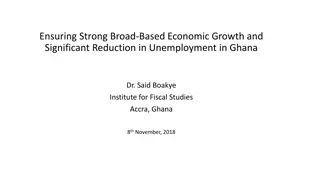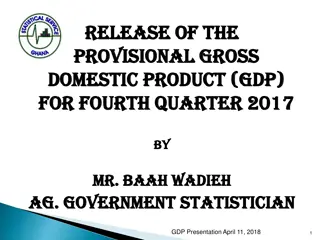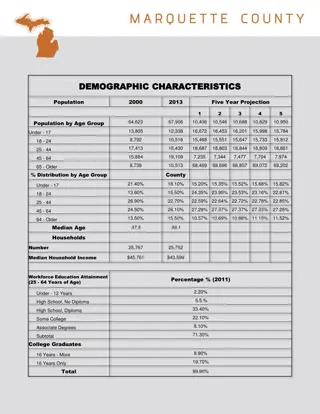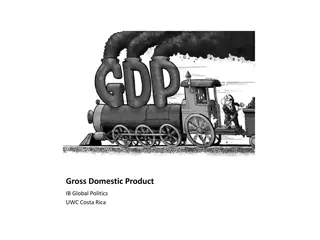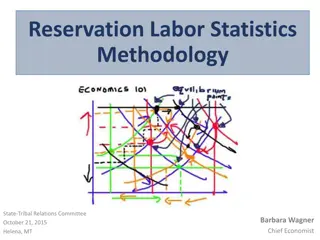Macroeconomic Measurement: GDP, Unemployment, and Labor Force Analysis
This content explores various aspects of macroeconomic measurement, including GDP calculation, real vs. nominal GDP, GDP deflator vs. CPI, and unemployment rates for different groups. It provides tables and figures to illustrate these concepts and data sources from reputable organizations like the U.S. Bureau of Economic Analysis and the Bureau of Labor Statistics.
Download Presentation

Please find below an Image/Link to download the presentation.
The content on the website is provided AS IS for your information and personal use only. It may not be sold, licensed, or shared on other websites without obtaining consent from the author.If you encounter any issues during the download, it is possible that the publisher has removed the file from their server.
You are allowed to download the files provided on this website for personal or commercial use, subject to the condition that they are used lawfully. All files are the property of their respective owners.
The content on the website is provided AS IS for your information and personal use only. It may not be sold, licensed, or shared on other websites without obtaining consent from the author.
E N D
Presentation Transcript
Chapter 8 Chapter 8 Macroeconomic Macroeconomic Measurement Measurement
Table 8.1 Gross Domestic Product, Spending Approach, 2018 Table 8.1 Gross Domestic Product, Spending Approach, 2018 Source: U.S.Bureau of Economic Analysis, National Income and Products Account, Table 1.1.5, October 4, 2019. Note: Totals may not add up exactly due to rounding.
Table 8.2 Calculation of Nominal GDP in an Apples Table 8.2 Calculation of Nominal GDP in an Apples- -and and- -Oranges Economy Oranges Economy
Table 8.3 Calculation of Constant Table 8.3 Calculation of Constant- -Dollar Real GDP Dollar Real GDP
Figure 8.1 Real versus Nominal GDP, Chained 2009 Dollars, 1980 Figure 8.1 Real versus Nominal GDP, Chained 2009 Dollars, 1980 2018 2018 Source: U.S. Bureau of Economic Analysis National Income and Product Accounts, Tables 1.1.5 and 1.1.6.
Figure 8.2 Rate of change in GDP deflator vs. CPI, 1960 Figure 8.2 Rate of change in GDP deflator vs. CPI, 1960- -2018 2018 Source: U.S. Bureau of Economic Analysis, National Income and Product Accounts Tables 1.1.4 and U.S. Bureau of Labor Statistics, Table on CPI-All urban consumers.
Figure 8.3 Who is in the Labor Force? Figure 8.3 Who is in the Labor Force? Source: U.S. Bureau of Labor Statistics, The Employment Situation September 2019, News Release.
Table 8.4 Unemployment Rates for Different Groups Table 8.4 Unemployment Rates for Different Groups Source: BLS News Release, The Employment Situation September 2019, October 8, 2019. * People are allowed to indicate more than one racial group. However, data from people who indicated more than one race are not included in these statistics. **Data on unemployment by education is for the age-group 25 years and over.
Figure 8.4 Average Subjective Well Figure 8.4 Average Subjective Well- -Being and GDP per Capita Being and GDP per Capita Sources: SWB from World Values Survey online data analysis, 2005 2008 survey wave; GDP from World Development Indicators online database. Note:The trend line is a statistically fitted line showing a best fit estimate of the relationship between the two variables on the graph, GDP per capita and SWB.
Table 8.5 Genuine Progress Indicator ($2012 per Capita), United States 2014 Table 8.5 Genuine Progress Indicator ($2012 per Capita), United States 2014 Source: Talberth and Weisdorf, 2017.
Figure 8.5 GPI vs. GDP per Capita, 1950 Figure 8.5 GPI vs. GDP per Capita, 1950- -2004 2004 Source: Talberth, John, Clifford Cobb, and Noah Slattery. 2007. The Genuine Progress Indicator 2006: A Tool For Sustainable Development. Redefining Progress. February, 2007.
Figure 8.6 BLI for Selected Countries, 2015 Figure 8.6 BLI for Selected Countries, 2015 Source: OECD, 2015.
Figure 8.7 Selected Countries as Ranked in the Human Development Index Figure 8.7 Selected Countries as Ranked in the Human Development Index Source: UNDP, Human Development Report, 2016 data.



